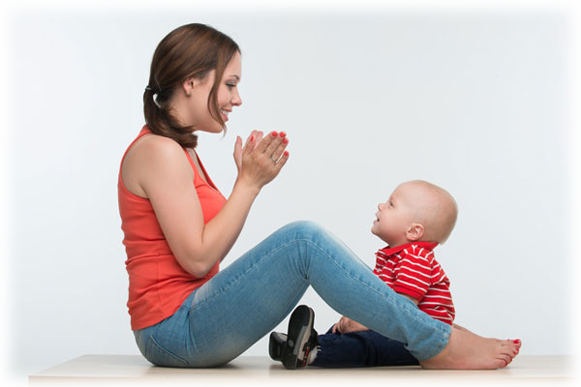
Have you ever wondered why parents are so pleased when their baby learns to wave bye-bye? This is one of the first natural forms of communication between you and your baby. This may be your baby’s first sign. Your baby will recognize what you are saying before your baby is able to speak. Using signs provides you with the ability to understand your baby and reduce frustration. Babies who are taught to communicate with signs naturally learn to speak sooner. Teach your baby to sign and she will begin adding words to her signs as soon as she is ready to speak.
All babies use their hands naturally in an attempt to communicate before they can speak. Your baby is likely to learn to wave bye-bye, clap her hands to express delight, shake her head to communicate “no” and point at objects that she wants. The problem is that the number of signs that your baby will use naturally without your help is very limited. The My Baby Can Talk video series fills that learning gap by offering you a resource to take advantage of this opportunity in a fun and entertaining format for both you and your baby to enjoy.
When to start
Just as all babies begin speaking at different ages, babies begin signing at different ages. You can begin signing with your baby at any time and your baby is likely to show a great deal of interest in your hand movements from a very young age. However, keep in mind that, on average, the motor skills necessary for babies to sign back to you mature at around 10 months of age.
Start with a few signs
Identify a few words that represent objects or actions that your baby is most interested in and begin with the signs for these words first. Your baby is more likely to be interested in signing with you if you focus on words that are of interest to her. Perhaps she has a favorite teddy bear (teach the sign for bear) or enjoys a story about a cat (teach the sign for cat) or loves to play with your shoes (teach the sign for shoes.)
Say the word whenever you sign
Signing with your baby is a bridge to speech. You will want to maintain a strong connection between the sign and the word so that once your baby learns to speak she will have already learned that signs and words are interchangeable. You will also want to give her the opportunity to sign or speak a given word as she grows older and is ready to speak.
Repeat the sign and the word often
Repetition is the key to success with signing as it is for speaking. The more times during a day you repeat the sign and the word, the sooner your baby will realize the connection between the sign and the object or action and begin signing back to you. You may want to make the sign before, during and after a given activity. For example:
“Do you want more cereal?” Make the sign for more.
“Here is more cereal.” Make the sign for more and give her more cereal.
“Now you have more cereal.” Make the sign for more.
Signing helps your baby identify one word out of a seemingly endless stream of sounds. By signing with your baby you are clearly marking the word that you are teaching and helping your baby to separate that one word from all the other words in the sentence. In addition, you are giving her valuable examples of the syntax of language by offering and marking the same symbol as it occurs in many distinct positions in many different sentences representing one unvarying object or action.

The more you include signing in your daily routine the sooner your baby will begin to sign with you. You may want to pick three of your baby’s favorite animals and then place toys and pictures of the animals in places that you frequent each day.
For example, a rattle with a dog on it at your baby’s changing table, a bottle with a picture of a duck on it, a stuffed animal bear in your baby’s crib, a book about dogs, a rubber duck to play with in the bath tub, and a bear toy to entertain your baby while she is eating. In addition, the signs for the words more, eat and drink, are good signs to use during mealtimes.
You can reinforce the signs for these favorite animals while saying nursery rhymes or while sings songs. A good song to sing while making your baby’s favorite animal signs is “Old MacDonald Had a Farm.” You can also spend time reading and looking at books that include these same animals.
You can try both verbal and nonverbal means to get your baby’s attention before making a sign. You can verbally ask your baby to look at you or you can lightly touch, tap or rub your baby. In addition, you can move an object of interest such as a toy towards you to draw your baby’s attention. You can also sign between your baby and the object of interest insuring that the sign is in your baby’s line of sight. Your baby is likely to learn the signs that you are teaching even if you do not seem to have her attention. At the same time, she is likely to learn quicker if you do have her attention and she is interested in the object or action that represents the sign that you are offering.
In the beginning it is important to give your baby a visual picture of the word and sign that you are teaching. This can either be the real object, a toy that represents the real object or a picture of the object. You want for your baby to see the sign, hear the word and also see the object that represents the word. Remember to include all visual forms of the word such as a real cat, a toy cat and a picture of a cat. If you only sign cat and say the word cat when you read a book about cats your baby may conclude that the sign and word for cat refers only to pictures of cats.
You are likely to have spent a great deal of time carrying on two sides of a conversation with your preverbal baby. It is important that you now allow enough time for your baby to respond. You can begin by asking questions and waiting at least 20 seconds, looking attentively and expectantly at your baby, before answering with both the word and the sign. This will give your baby the clue that you are now inviting her into your conversation.
Your baby will have a great number of opportunities to see the signs that you will teach her. It is also helpful for a baby to feel a sign. Some signs that are good candidates for this are: bath, cat and dog. You can simply use your hands to make the same movements on your baby’s body as you would on your own. You may want to have your baby in your lap when you make signs on your baby’s body to make it easier for you to make the sign correctly.
Sometimes it is helpful to show your baby how to make a sign by gently guiding her hands. This is called hand over hand signing. Please only do this if your baby enjoys the help. Your baby may not like having her hands manipulated. If your baby shows any displeasure then you should immediately stop. Your baby will learn to sign even if you do not help her to sign in this way.

You can encourage your baby to sign with you by asking her to “show me with your hands” while at the same time gently tapping her hands. You can also play a game where a favorite toy is placed out of reach and then you make the sign and bring the toy to your baby. You can then place the toy out of reach and ask your baby to make the sign. Always help your baby by making the sign for her if she has not made the sign within a short period of time or if she becomes frustrated.
Babies are not likely to reproduce any given sign perfectly when they first begin to sign in just the same way that babies do not always pronounce words correctly once they begin to speak. However, you should continue to offer the correct sign. It is likely that your baby believes that she is making the same hand movements as you are even if she is not. If you change your sign to match your baby’s sign then she is likely to become confused as to the correct sign to use.
A case in point is with Jessica and her grandfather. One day Jessica’s grandfather came to visit and saw Jessica making the sign for “bear” before she picked up her favorite bear. Thrilled with Jessica’s ability to communicate through signing, Grandpa John signed back to Jessica with the exact hand movements that Jessica had used. Jessica became upset and repeatedly signed back the same modified version of the sign for bear. Finally, Jessica grabbed her grandfather’s hand and dragged him to her mother. She literally danced around the room when Grandpa John finally signed the correct version of the sign.
There will be many times during the day that you only have one free hand to use to sign with your baby. Many times you may be holding your baby at the same time that you want to show her a sign. Remember that your baby is perceptive enough to understand a sign that normally requires two hands but is made with one hand as long as you also take the time to make the same sign with two hands at other times during the day. The best time to teach your baby to sign and use both of your hands is while watching the video together.
Babies who sign at a young age show a higher level of interest in books than their non-signing peers. This is most likely because they can interact with their parents while looking at books. You can select books that include your baby’s favorite objects and then offer her the sign whenever you say the word for the object. Watch your baby’s eyes to see the images that she is most attracted to in the book, comment on the image, offer the sign for the image and then allow time for her to respond.
Whenever your baby asks for something with a sign you should immediately reward her by fulfilling her request. If for some reason you cannot give her what she is asking for then make sure that you reward your baby in some other way and make it clear to her that you understand what she asked for.
Likewise, every time you believe that your baby is attempting to sign to you, you should reward her for her attempts. If you are not sure of the sign that she is making then you can ask her with words and signs to help you to understand better. For example, “Are you making the sign for ‘shoes’ or are you making the sign for ‘socks’?” Remember to present the words and signs at the same time.

It is important to remember that your baby is very much like you are only with fewer experiences. Your baby will learn to sign more quickly if she enjoys the process of learning and she is consistently rewarded for every attempt to communicate with you in this way. The more fun that you both have with signing together the more motivated your baby will be to want to learn more. Remember that this is not about the number of signs that your baby learns or how perfectly your baby makes signs but the ability to communicate with you before she is able to speak. Laugh, play and smile – your baby is talking to you!
